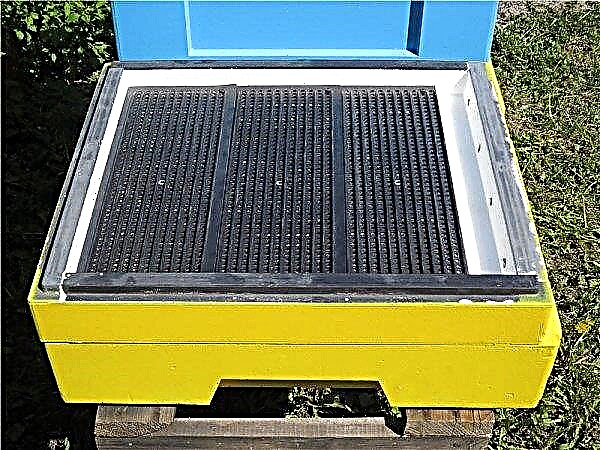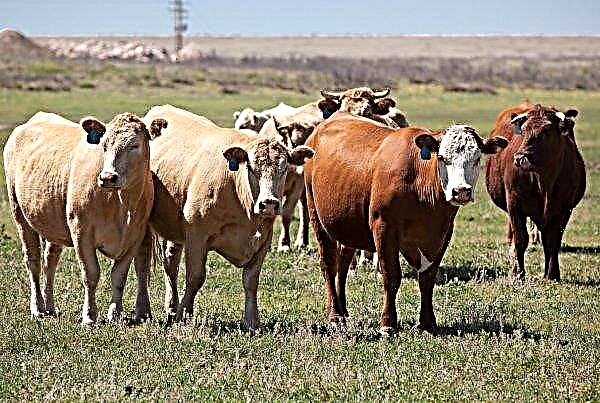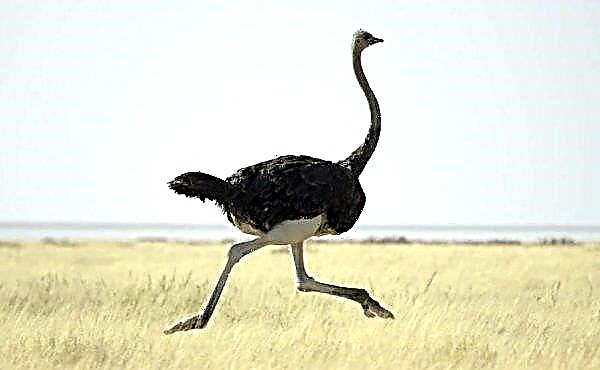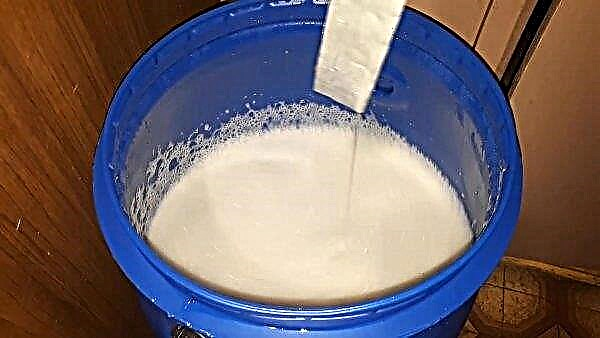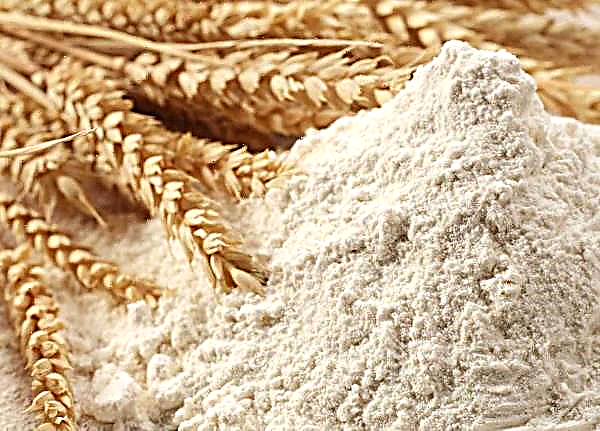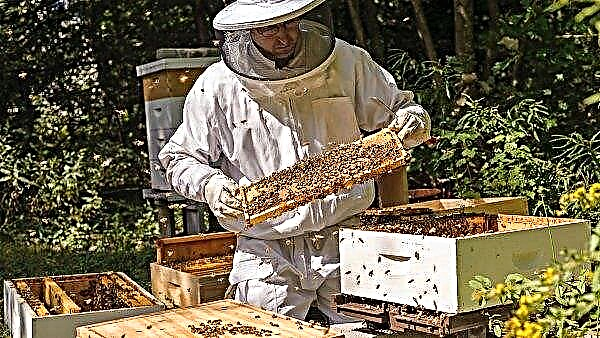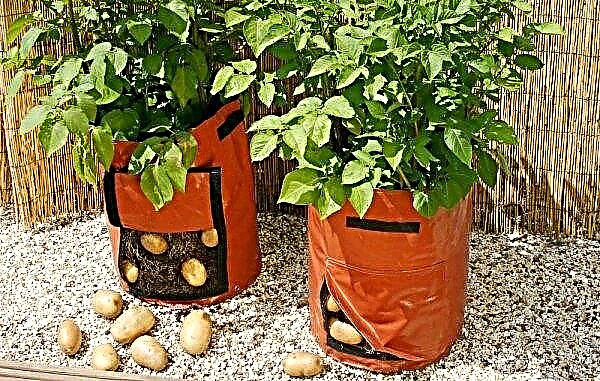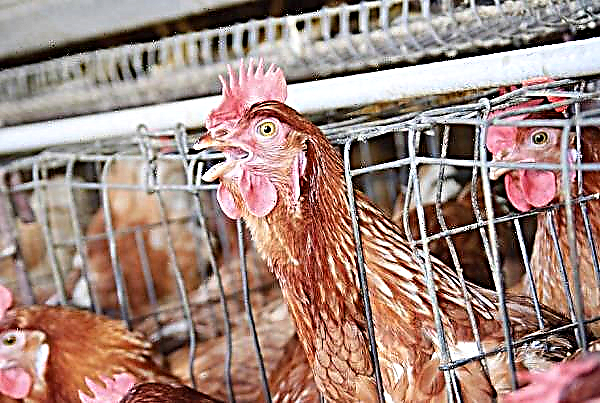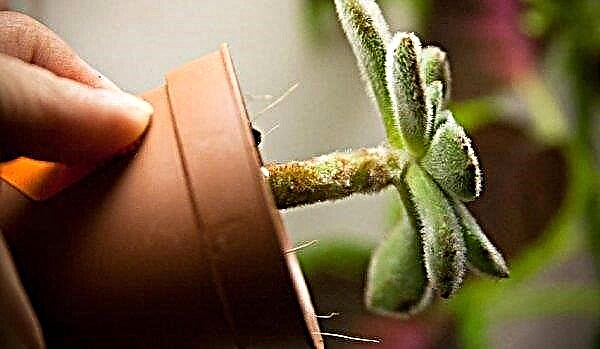Juniper scaly "Holger" (Juniperus squamata Holger) is an evergreen ornamental shrub that is a member of the Juniper genus and belongs to the Cypress family. In landscape design, it is widely used for decorating home gardens. In order for the bush to become a decoration of the garden, you must first familiarize yourself with the description of the variety, as well as the rules for planting and growing.
Botanical Description
Juniper scoamat “Holger” is a stunted coniferous shrub that reaches a height of only 80–100 cm. The crown has a sprawling shape and, growing rapidly, reaches a diameter of 1.5–2 m. The branches are horizontal and taper closer to the tips. The annual growth of branches is about 10 cm. The needles are silver-green in color with a slight blue tint. Young shoots are light green in color. The colors of the needles are harmoniously combined and look very impressive. In winter, the color of the bush does not change to yellow. Fruits juniper with large cones of a grayish color. The plant is resistant to frost and can withstand temperatures up to -35 ° C.

Landing
Compliance with the rules of planting guarantees good survival and harmonious development of the plant, so you should pay special attention to them.
Planting technology includes the following steps:
- preparation of planting material;
- site selection and soil preparation;
- landing.
Video: Juniper Scaly Holger
Seedling preparation
The seedling intended for planting must be healthy and have a developed root system. Suitable planting material age 3 years. Before removing planting material from the container, it is recommended to water it abundantly and leave it for several hours. Well-moistened soil makes it easy to get a seedling without damaging the roots. The young plant is transplanted to a permanent place using the “transshipment” method, that is, together with a lump.
 Sapling can be purchased in a specialized nursery. It is recommended to buy a rooted plant growing in a container
Sapling can be purchased in a specialized nursery. It is recommended to buy a rooted plant growing in a container
Site selection and preparation
Juniper can only be planted in open, well-lit areas. To maintain a saturated color, the plant needs active photosynthesis. In places with insufficient sunlight, the needles will turn pale and lose their bright colors. Juniper "Holger" is resistant to wind and drafts, so open spaces will not damage it. For the full development of the shoots requires a lot of space.
Important! The distance between the bushes should be at least 1 m, since the branches of the bush grow quite sprawling. Close-planted plants will interfere with each other's development and can cause diseases.
The bush is unpretentious to the composition of the soil. It grows well in both acidic / neutral and not very salty soils.. Earth, in which there is a small amount of alkali, also does not harm the plant.
Preparing a landing site also includes weeding the site and creating a landing pit. The depth of the hole should be greater than the root system of the seedling. The most suitable pit parameters are 70 cm deep and 70 cm wide.
Video: Planting and caring for juniper
Landing process
Landing should be carried out carefully and carefully. Simple recommendations will help to avoid damage to the root system and ensure rapid growth.
Landing Rules:
- Put a layer (20 cm) of drainage (broken brick, gravel, stones) into the landing pit.
- Add a layer of compost 10-15 cm.
- Install the seedling by carefully placing the earthen lump in which the roots are located. The root neck of a large seedling should be 10 cm above the pit, and the young plant at ground level.
- Sprinkle with earth without tamping. It is enough to slightly compact the soil in the circumferential area.
- Water the planting site with 12 liters of water.

Juniper Care
After planting, it is important to provide the plant with proper care. The quality of the needles, its color and the decorativeness of the shoots will depend on the literacy of its implementation.
Juniper care includes:
- watering;
- top dressing;
- loosening;
- mulching;
- pruning
- preparation for winter;
- disease prevention and pest control.
Juniper has the ability to adapt to environmental conditions. This plant is extremely unpretentious in the care, but in the dry period it requires shading. You can cover the plant with light tissue to protect young shoots from burns.
Watering
The shrub is able to withstand drought conditions and lack of moisture in the soil. During each season (spring, autumn, winter, summer), watering is carried out 3-4 times, pouring 12 liters of water under each bush. In summer, it is advisable to carry out watering more often. Sprinkling the crown is not superfluous. However it is recommended to irrigate the top of the bush early in the morning before sunrise and in the evening at sunset. This measure will help protect the shoots from intense evaporation of moisture. "Shower" flushes dirt and dust from the needles, refreshes it and additionally moisturizes the air.

Top dressing
Light, poor soils can be enriched with organic fertilizers, such as humus (it is obtained from rotted manure), compost or food waste.
Complex NPK + Me fertilizers are applied according to the following system:
- Spring - nitrogen, for example, Ammophos. 25 g of fertilizer are applied per 1 m²;
- summer - phosphoric, for example, "Superphosphate" (granular). Under each bush make 0.5 l of fertilizer diluted in 10 l of hot water;
- end of summer - beginning of autumn - potash. Potassium metaphosphate is suitable as a top dressing. Under each bush, you need to make 15 g of fertilizer.
Video: Fertilizers for conifers
Loosening and mulching
Loosening is necessary to remove the salt crust that forms on the topsoil. Also, fluffing the earth, you can facilitate the access of oxygen and moisture to the roots. However, it should be remembered that the depth of processing should be small, since the root neck of the shrub is close to the surface of the earth. It is also necessary to regularly weed the ground, removing weeds.
Mulching will help maintain moisture in the soil. To do this, you can use peat, showered with needles and wood chips. These organic materials must be mixed and spread around the barrel with a layer of approximately 5 cm.
Did you know? Juniper is one of the oldest plant species. Its existence spans 50 million years.
Pruning
In order for the crown of juniper to maintain a decorative form, its shoots need to be cut in time. The procedure involves the removal of dry and broken branches. Healthy shoots are not removed, as the shrub grows slowly. The procedure can be performed at any time of the year. Juniper branches contain toxic substances, so you need to cut them only with gloves.

Winter preparations
Shelter for the winter is required only in the first year after planting. To do this, you can use light but warm material, such as burlap, which will protect the young plant from gusts of cold wind and exposure to low temperatures. Mulching, which is carried out in late autumn and removed in early spring, is not superfluous. An adult plant does not need preparation for the winter period, since it belongs to winter-hardy plants and is insensitive to wind and drafts.

Possible diseases and pests
Despite good health, Holger Juniper is susceptible to pests and diseases.. To protect the plant and maintain its health, you need to regularly inspect it and, when the first signs of damage appear, immediately take measures.
Diseases and pests, as well as signs of damage:
Treatment of diseases involves the use of fungicides, such as Scor, Switch, Maxim and Ordan. In order to avoid infection of the shrub, for prophylaxis, it is necessary to spray the trunk section using Fitosporin and Fundazol. The most common cause of disease is the close proximity of shrubs, so dense plantings are recommended to thin out.
Important! If signs of damage by root cancer have been noticed, the plant must be immediately dug up and destroyed. And to disinfect the place where it grew with the use of copper sulfate.
Pests such as spider mites, aphids and juniper moths live on the upper parts of the bush, sucking its juices. As a fight against them, treatment with insecticides, for example, Aktara and Angio, helps. When parasites are detected, it is necessary to completely spray the plant with these insecticides. As a preventive measure, the procedure should be carried out in spring and summer.

Breeding methods
Juniper can be propagated at home. This is especially necessary if you plan a group planting of bushes.
Reproduction occurs in three ways:
- Seeds. Collect them from cones should be in the fall. Then it is necessary to stratify. To do this, place the seeds in containers with earth and take them outside. In this case, stratification will be natural: snow will powder the surface of the earth in which the seeds are located and create the necessary conditions for storage. Saving in this way is necessary for 150 days. With the onset of spring, in May, germinated seeds can be planted in open ground in a permanent place.

- Cuttings. Cuttings can be harvested from late April to mid-May. To do this, on a ten-year shrub, you need to select annual shoots and cut 10 cm from the top. At the base of the cuttings, you need to remove 5 cm of needles. A small piece of wood from the mother plant should be present on the harvested material. The bark on the workpiece must be carefully cut using garden shears. After preparation, the cuttings must be placed for a day in a solution of a growth stimulator, for example, “Heteroauxin”. They need to be rooted in a mixture of sand and peat in equal parts. Then the container with the material should be covered with a film and provide moderate shading. Further care includes spraying. After 30–45 days, the root system begins to form. In June - July, seedlings can be replanted in open ground. The next 2-3 years, the plant must be covered with spruce branches for the winter. After this period, a young bush can be transplanted to a place where it will grow constantly.

- Layering. To propagate the bush by layering, you need to choose the longest and youngest shoot, then clean its tip from the needles. About 5 cm needles must be removed. Then place the branch in the ground end down and secure with a hairpin. The clamping place needs to be watered periodically, loosened and rid of weeds. Rooting takes 6–12 months. After the shoot has taken root, the branch needs to be separated from the mother bush and transplanted to a permanent place. Juniper propagates by layering in spring. It is possible to transplant a bush obtained in this way at any time of the year.

Use in landscape design
Juniper is planted singly or in small pairs to decorate park areas and small gardens. It is well suited for filling voids in vast areas. When planting on slopes and slopes, long branches form a kind of cover that looks original and unusual. Shrubs are often grown in rockeries and on alpine hills.
Did you know? Juniper is a long-lived plant. The life span of this shrub is about 600 years.
Juniper cultivar "Holger" is great for growing at home. This shrub is extremely unpretentious in care. Plant and grow it under the force of even a novice gardener. The main advantage of decorative juniper is the soft needles, which retains its rich color throughout the year, as well as a characteristic pleasant aroma.




